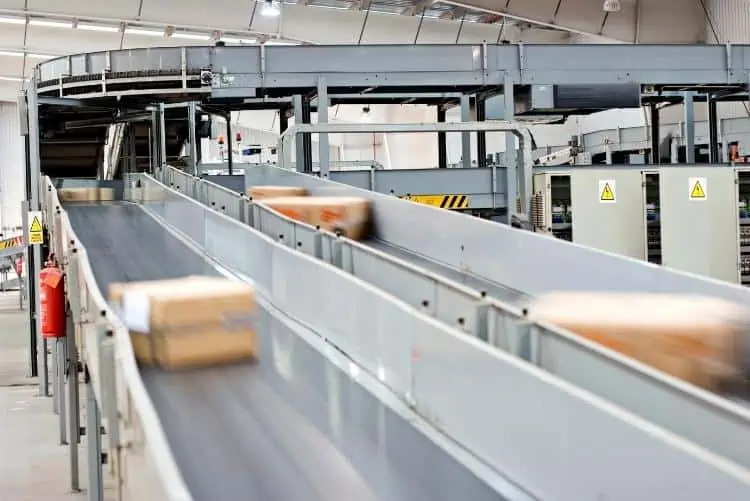At a construction site, we always intend to add things that make our whole process easy and safe. Time factor plays a crucial role in any construction, and the conveyor belt comes as a rescue with other things. You must be wondering what it is and how it works! Keep reading to know everything.

What is a Conveyor Belt?
A conveyor belt is a continuously moving, efficient mechanical handling apparatus that automatically transports objects from one place to another. You can use it in a range of industries, at construction sites and shopping malls.
How is a Conveyor Belt made?
A conveyor belt is a looped belt driven by and wrapped around one or more pulleys. Powered by an electric motor, it is also backed by a metal plate bed or rollers on which the conveyor belt lies; it works efficiently. The drive pulley powers a conveyor belt and has an unpowered idler pulley.
Pulley drives at the discharge end of a conveyor belt are referred to as head drives, while ones located at the infeed end are known as tail drives. The preferred type of pulley drive is a head drive located at the discharge end and uses pull force to move a conveyor belt. There are an endless number of types and uses for conveyors. All of the varieties serve the purpose of transporting materials and goods along a continuously moving path. Though motorized conveyor belts are the traditional form of a conveying system, some systems use rollers without a motor to move materials.
How is a Conveyor Belt necessary?
This system minimizes human error, lowers risks at the workplace, and reduces labor costs, meaning it is vital on a construction site. Finding a good, reliable conveyor belt hiring company is important to ensure safety and efficiency.
Types of Conveyor Belt.
There are various conveyor types, and each type serves a specific purpose.
- Roller Bed Conveyor Belt
- Flat Belt Conveyor Belt
- Modular Conveyor Belt
- Cleated Conveyor Belt
- Curved Conveyor Belt
- Incline Conveyor Belt
- Decline Conveyor Belt
- Filter Conveyor Belt
- Timing Conveyor Belt
- Sandwich Conveyor Belt
- Anti-Static Conveyor Belt
Uses of Conveyor Belt
A conveyor system has different types of uses:
- Conveyor Belts transports a large amount of material very swiftly and steadily.
- Stack materials at the end of a transportation line.
- Conveyor Belt helps you move a product vertically or horizontally with flexibility

Advantages of a Conveyor Belt
The benefits of using a conveyor belt system are as follows:
- Reduce labor while significantly raising productivity and time efficiency.
- Protect workers from any health damages that can be induced by carrying heavy loads.
- It prevents product damage, which can happen during transportation.
- Effortless transfer of a product in a different route.
- The best thing about this system is how low maintenance it is.
Conveyor Belt Applications
Conveyor systems work across many industries, including air travel, mining, manufacturing, pharmaceuticals, food processing, etc.
The conveyor belt system’s maximum unit mainly consists of pulleys and clamping straps. Selecting the right add-ons for your industry’s needs is very important, as extra stands or lateral guides are mandatory for different modifications and functions.
Parts and operations of the conveyor belt system also include:
Frame: The frame’s structure holds all mobility parts together for a more guarded operation.
The belt: The conveyor belt support: Rollers help the belt to stay intact and carefully continue the action. The rollers also keep the objects in place and avert the belt from being discouraged.
The driving unit: Motors may use variable or constant speed-rebate gears to power the conveyor belt. An efficient driving unit helps the belt with repeated running, smooth reversing, and repeatedly adjusting direction.
Pulleys: The conveyor belt should coil over two or more pre-planned stationed pulleys. You need to perform demeaning functions like tracking the belt, turning, redirecting, tensioning, and driving as the pulley controls the belt’s movement.
Clamping straps: Clamping straps are used on many machines to suppress fixtures and work parts.
Add-on modules: Many additional parts are installed for further aid. Some parts support the belt from within, like rollers, whereas stands and lateral guides support the outer part.
Conclusion
- A conveyor belt is a material handling system anticipated to move supplies, materials, and components using an active and effortless process that saves time, energy, and cost.
- There are numerous kinds and uses for conveyor belts. All of the varieties serve the purpose of transporting materials and goods along a continuously moving path.
- Regardless of the materials used to produce a conveyor belt, all types are to move products, materials, supplies, and components efficiently and smoothly from one point to another.
- Pulleys are an essential part of belt conveyors. They help provide drive tension and change the direction of the movement of the belt. Belt conveyor pulleys are classified as drive, tension, motorized, snub, wing, and bend pulleys that can be smooth, rubber coated, or cast rubber.



